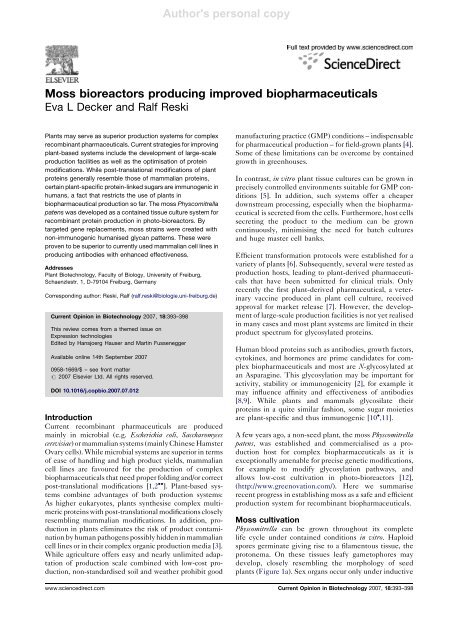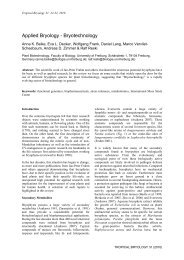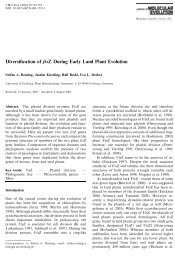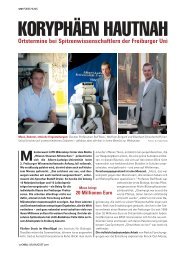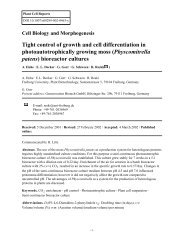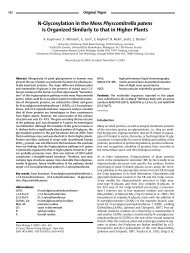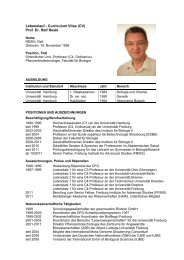Moss bioreactors producing improved biopharmaceuticals - Plant ...
Moss bioreactors producing improved biopharmaceuticals - Plant ...
Moss bioreactors producing improved biopharmaceuticals - Plant ...
Create successful ePaper yourself
Turn your PDF publications into a flip-book with our unique Google optimized e-Paper software.
Author's personal copy<br />
<strong>Moss</strong> <strong>bioreactors</strong> <strong>producing</strong> <strong>improved</strong> <strong>biopharmaceuticals</strong><br />
Eva L Decker and Ralf Reski<br />
<strong>Plant</strong>s may serve as superior production systems for complex<br />
recombinant pharmaceuticals. Current strategies for improving<br />
plant-based systems include the development of large-scale<br />
production facilities as well as the optimisation of protein<br />
modifications. While post-translational modifications of plant<br />
proteins generally resemble those of mammalian proteins,<br />
certain plant-specific protein-linked sugars are immunogenic in<br />
humans, a fact that restricts the use of plants in<br />
biopharmaceutical production so far. The moss Physcomitrella<br />
patens was developed as a contained tissue culture system for<br />
recombinant protein production in photo-<strong>bioreactors</strong>. By<br />
targeted gene replacements, moss strains were created with<br />
non-immunogenic humanised glycan patterns. These were<br />
proven to be superior to currently used mammalian cell lines in<br />
<strong>producing</strong> antibodies with enhanced effectiveness.<br />
Addresses<br />
<strong>Plant</strong> Biotechnology, Faculty of Biology, University of Freiburg,<br />
Schaenzlestr. 1, D-79104 Freiburg, Germany<br />
Corresponding author: Reski, Ralf (ralf.reski@biologie.uni-freiburg.de)<br />
Current Opinion in Biotechnology 2007, 18:393–398<br />
This review comes from a themed issue on<br />
Expression technologies<br />
Edited by Hansjoerg Hauser and Martin Fussenegger<br />
Available online 14th September 2007<br />
0958-1669/$ – see front matter<br />
# 2007 Elsevier Ltd. All rights reserved.<br />
DOI 10.1016/j.copbio.2007.07.012<br />
Introduction<br />
Current recombinant pharmaceuticals are produced<br />
mainly in microbial (e.g. Escherichia coli, Saccharomyces<br />
cerevisiae) or mammalian systems (mainly Chinese Hamster<br />
Ovary cells). While microbial systems are superior in terms<br />
of ease of handling and high product yields, mammalian<br />
cell lines are favoured for the production of complex<br />
<strong>biopharmaceuticals</strong> that need proper folding and/or correct<br />
post-translational modifications [1,2 ]. <strong>Plant</strong>-based systems<br />
combine advantages of both production systems:<br />
As higher eukaryotes, plants synthesise complex multimeric<br />
proteins with post-translational modifications closely<br />
resembling mammalian modifications. In addition, production<br />
in plants eliminates the risk of product contamination<br />
by human pathogens possibly hidden in mammalian<br />
cell lines or in their complex organic production media [3].<br />
While agriculture offers easy and nearly unlimited adaptation<br />
of production scale combined with low-cost production,<br />
non-standardised soil and weather prohibit good<br />
manufacturing practice (GMP) conditions – indispensable<br />
for pharmaceutical production – for field-grown plants [4].<br />
Some of these limitations can be overcome by contained<br />
growth in greenhouses.<br />
In contrast, in vitro plant tissue cultures can be grown in<br />
precisely controlled environments suitable for GMP conditions<br />
[5]. In addition, such systems offer a cheaper<br />
downstream processing, especially when the biopharmaceutical<br />
is secreted from the cells. Furthermore, host cells<br />
secreting the product to the medium can be grown<br />
continuously, minimising the need for batch cultures<br />
and huge master cell banks.<br />
Efficient transformation protocols were established for a<br />
variety of plants [6]. Subsequently, several were tested as<br />
production hosts, leading to plant-derived pharmaceuticals<br />
that have been submitted for clinical trials. Only<br />
recently the first plant-derived pharmaceutical, a veterinary<br />
vaccine produced in plant cell culture, received<br />
approval for market release [7]. However, the development<br />
of large-scale production facilities is not yet realised<br />
in many cases and most plant systems are limited in their<br />
product spectrum for glycosylated proteins.<br />
Human blood proteins such as antibodies, growth factors,<br />
cytokines, and hormones are prime candidates for complex<br />
<strong>biopharmaceuticals</strong> and most are N-glycosylated at<br />
an Asparagine. This glycosylation may be important for<br />
activity, stability or immunogenicity [2], for example it<br />
may influence affinity and effectiveness of antibodies<br />
[8,9]. While plants and mammals glycosilate their<br />
proteins in a quite similar fashion, some sugar moieties<br />
are plant-specific and thus immunogenic [10 ,11].<br />
A few years ago, a non-seed plant, the moss Physcomitrella<br />
patens, was established and commercialised as a production<br />
host for complex <strong>biopharmaceuticals</strong> as it is<br />
exceptionally amenable for precise genetic modifications,<br />
for example to modify glycosylation pathways, and<br />
allows low-cost cultivation in photo-<strong>bioreactors</strong> [12],<br />
(http://www.greenovation.com/). Here we summarise<br />
recent progress in establishing moss as a safe and efficient<br />
production system for recombinant <strong>biopharmaceuticals</strong>.<br />
<strong>Moss</strong> cultivation<br />
Physcomitrella can be grown throughout its complete<br />
life cycle under contained conditions in vitro. Haploid<br />
spores germinate giving rise to a filamentous tissue, the<br />
protonema. On these tissues leafy gametophores may<br />
develop, closely resembling the morphology of seed<br />
plants (Figure 1a). Sex organs occur only under inductive<br />
www.sciencedirect.com Current Opinion in Biotechnology 2007, 18:393–398
394 Expression technologies<br />
conditions, giving rise to the diploid sporophyte with<br />
persistent spores. While sexual reproduction occurs predominantly<br />
when growing moss on agar plates (Figure 1b)<br />
and requires inductive conditions, culture in liquid media<br />
such as flasks and <strong>bioreactors</strong> (Figure 1c,d) favours vegetative<br />
growth. Techniques have been established to<br />
maintain Physcomitrella predominantly in the actively<br />
growing filamentous form. In addition, for long-term<br />
storage of moss strains, efficient cryo-protocols were<br />
established [13] and realised in the International <strong>Moss</strong><br />
Stock Centre (http://www.moss-stock-center.org/).<br />
Some in vitro cultures of seed plants rely on de-differentiated<br />
cells and thus harbour inherently the risk of<br />
genetic instability. In contrast, intact moss plants (protonema)<br />
are grown in simple media of inorganic salts with<br />
airborne CO 2 as sole carbon source. Consequently,<br />
genetic instabilities were never observed in Physcomitrella<br />
in vitro cultures. Cell differentiation and plant growth can<br />
be tightly controlled by distinct parameters [14]. On a<br />
small scale, moss plants are grown in agitated glass flasks.<br />
On a scale up to 15 L, growth takes place in highly<br />
controllable photo-<strong>bioreactors</strong>, either in stirred glass tanks<br />
(Figure 1c) or in a modular, fully scalable glass tubular<br />
reactor (Figure 1d) [15–18]. A 30-L tubular moss bioreactor<br />
was established and parameters for high-density<br />
and uniform moss cultures determined for batch [17 ]as<br />
well as continuous cultivation [16]. Currently, a modular<br />
100-L photo-bioreactor is being established for the production<br />
of complex <strong>biopharmaceuticals</strong> according to<br />
GMP standards (http://www.greenovation.com/).<br />
Increasing product yields<br />
Well-established protocols for the generation of stable<br />
transgenic moss strains [13,19] were modified to establish<br />
a transient expression system that allows proof of principle<br />
within days [20]. Recently, the Physcomitrella genome was<br />
fully sequenced (http://www.cosmoss.org/) as the fourth<br />
plant genome after Arabidopsis, rice and poplar. From that,<br />
a comprehensive phylogenetic database for plant transcription<br />
factors was established [21], facilitating the design of<br />
highly effective Physcomitrella production strains. The<br />
strengths of various heterologous promoters from plants<br />
and animals were quantified in Physcomitrella and compared<br />
to endogenous promoters [22], including moss tubulin<br />
and actin promoters [23,24], thus generating a set of<br />
vectors activating gene expression in Physcomitrella within<br />
three orders of magnitude. In addition, several promoters<br />
were identified to be inducible, for example by the plant<br />
hormone indole acetic acid (IAA, an auxin) [25,26] orby<br />
moderate heat shock [27], in Physcomitrella.<br />
Short N-terminal peptide extensions may navigate<br />
proteins from the cytosol to specific organelles. For most<br />
post-translational modifications, such as N-glycosylation,<br />
a passage through the endoplasmic reticulum and the<br />
Golgi-Apparatus is required. At the same time, this is the<br />
Author's personal copy<br />
preferred route for the vast majority of extra-cellular<br />
proteins. In various studies such signal peptides were<br />
evaluated for functionality in Physcomitrella. Even though<br />
signal peptides from human sequences were functional in<br />
moss, most plant-derived signal peptides were more efficient<br />
in targeting recombinant proteins to the secretory<br />
system [24,28]. In addition, signal peptides for intracellular<br />
storage of proteins in chloroplasts, mitochondria or the<br />
central vacuole were identified and characterised via reporter<br />
fusions with fluorescent proteins [29–34].<br />
Protein recovery was markedly increased by addition of<br />
stabilising agents (polyvinylpyrrolidone (PVP), human<br />
serum albumin (HSA)) to the moss medium [35 ]. However,<br />
at higher concentrations these agents lead to foam<br />
formation and thus interfered negatively with the cultivation<br />
process as well as with downstream processing.<br />
Moreover, adding commercial HSA would introduce a<br />
putative source of product contamination. These challenges<br />
were elegantly overcome by co-expressing recombinant<br />
HSA and the recombinant biopharmaceutical in<br />
one production strain [35 ]. These strains produced only<br />
tiny amounts of recombinant HSA, far too low to be<br />
beneficial when added to control strains. Although the<br />
precise mechanism by which HSA stabilises recombinant<br />
proteins in the medium is unknown, it is plausible to<br />
assume that the co-production of HSA and a second<br />
protein in one plant facilitates their interactions already<br />
during their joint passage through the endoplasmic reticulum.<br />
The implementation of cross-flow filtration in the tubular<br />
bioreactor module allowed a robust and flexible perfusion<br />
of the suspension. Thus, secreted recombinant human<br />
VEGF (vascular endothelial growth factor) was harvested<br />
and concentrated via continuous product separation [16].<br />
The secretory moss expression system was also used for<br />
transient protein production allowing quick feasibility<br />
studies of expression cassettes, transgenic moss strains,<br />
or new products [23,24,28,33,36 ,37]. This transient system<br />
was optimised for expression of recombinant human<br />
VEGF up to 10 mg/mL [20].<br />
Engineering product quality<br />
All non-human expression hosts synthesise recombinant<br />
proteins with slight differences to their human counterpart.<br />
While folding and assembly of multimeric proteins is<br />
essentially the same in all higher eukaryotes (e.g. plants<br />
and mammals), post-translational modifications are<br />
species-specific. This is one of the reasons why mammalian<br />
cell lines such as Chinese Hamster Ovary (CHO)<br />
cells are currently the system of choice. Therefore, plant<br />
systems should be adaptable to human glycosylation to<br />
become a realistic alternative to CHO cells. An appropriate<br />
production host is genetically well-characterised<br />
and amenable for genetic modifications. The Physcomitrella<br />
genome has recently been sequenced and large<br />
Current Opinion in Biotechnology 2007, 18:393–398 www.sciencedirect.com
Figure 1<br />
amounts of EST data comprise more than 95% of the<br />
transcribed moss genes [38–40]. Codon usage in moss<br />
allows expression of human genes without previous codon<br />
adaptation [39]. The genetically most interesting feature<br />
of Physcomitrella is the high degree of homologous recombination<br />
in its nuclear DNA, greatly facilitating precise<br />
and base-specific targeted gene knockouts, a possibility<br />
still not given for any other plant.<br />
Parallel to the exploitation of the moss transcriptome,<br />
protein N-glycosylation was characterised and shown to<br />
exhibit the same structures as in higher plants [41,42]. In<br />
addition, the glycosyltransferase genes responsible for<br />
key steps of complex-type glycosylation were identified<br />
and isolated from the moss genome [41].<br />
The most critical differences between plant and human<br />
glycosylation are two plant-specific sugar moieties, a xylose<br />
connected to the core mannose residue by beta1,2-linkage<br />
and a fucose, alpha1,3-linked to the proximal N-acetylglucosamine<br />
(GlcNAc) residue of the core glycan (Figure 2).<br />
While xylose is unknown in human glycans, the proximal<br />
fucose residue in human glycans is linked in a different way<br />
(alpha1,6). Both plant-specific sugars are immunogenic.<br />
Author's personal copy<br />
<strong>Moss</strong> <strong>bioreactors</strong> Decker and Reski 395<br />
In vitro cultivation of a moss, Physcomitrella patens for production of <strong>biopharmaceuticals</strong>. (a) Life cycle of mosses with haploid (1n) and diploid<br />
(2n) stages. R!: meiosis (b) Storage of transgenic moss lines on multi-well agar plates. (c, d) In vitro propagation of moss protonema in stirred<br />
glass-tank and tubular photo<strong>bioreactors</strong>, respectively. Photographs courtesy of Andreas Schaaf (b) and Clemens Posten (TU Karlsruhe; d).<br />
About one-quarter of individuals with allergies developed<br />
antibodies of the allergy-relevant IgE class which specifically<br />
recognise xylose or fucose-containing complex-type<br />
glycans. However, the clinical relevance of carbohydratespecific<br />
antibodies is still questionable [10 ,43]. <strong>Moss</strong><br />
knockout strains were created which lacked the enzymes<br />
responsible for xylosylation and fucosylation, beta1,2-xylosyltransferase<br />
and alpha1,3-fucosyltransferase, respectively<br />
[37]. The resulting double knockout strains were<br />
completely devoid of the allergenic sugar residues and<br />
were employed to synthesise several products of pharmaceutical<br />
value, including human VEGF [37], IgG class<br />
antibodies [44,45], and erythropoietin [46].<br />
Further ‘humanisation’ of plant N-glycans comprised<br />
expression of a human beta1,4-galactosyltransferase,<br />
responsible for linking terminal galactose to mammalian<br />
N-glycans [47]. In addition, the engineering of plant<br />
genomes in order to attach sialyl residues to the ends<br />
of sugar chains was realised recently [48 ]. The humanlike<br />
galactosylation was also realised by ‘knockin’ of the<br />
human galactosyltransferase gene in the xylosyltransferase<br />
and fucosyltransferase locus, respectively, from<br />
double knockout moss strains [36 ,44].<br />
www.sciencedirect.com Current Opinion in Biotechnology 2007, 18:393–398
396 Expression technologies<br />
Figure 2<br />
Typical structures of antibody N-glycosylation. The sugar chains are<br />
linked to the protein via the proximal GlcNAc residue (right).<br />
Unmodified moss glycan containing terminal galactose and fucose<br />
residues (top). Typical bisecting human antibody glycan (middle).<br />
Glyco-optimised moss N-glycan providing antibodies with <strong>improved</strong><br />
ADCC (bottom). F: fucose; X: xylose. Sugars or linkages that may<br />
result in immunogenicity or low effector function are marked in red.<br />
Sialic acid residues are linked to many human blood<br />
proteins and enhance their half-life in the circulation<br />
[49]. However, monoclonal antibodies – probably the<br />
most interesting and largest group of biotech drugs –<br />
bear one conserved glycosylation site with an attached<br />
N-glycan, and are only rarely sialylated. Furthermore,<br />
these occasionally occurring sialic acid residues seem to<br />
have no obvious function. Therefore, plant-based antibody<br />
production with appropriate glycosylation is a realisable<br />
task which was recently fulfilled in Physcomitrella<br />
[44].<br />
Moreover, by glyco-engineering via targeted gene knockouts,<br />
the quality of plant-produced antibodies could even<br />
be superior to that of CHO cells. The pharmacological<br />
efficiency of some antibodies produced in mammalian<br />
systems is rather disappointing due to weak antibodydependent<br />
cellular cytotoxicity (ADCC), an important<br />
effector function of antibodies. ADCC is mediated by<br />
receptor (FcgammaRIII) binding of IgG antibodies. This<br />
IgG-receptor binding affinity is increased in antibodies<br />
lacking the human core fucose residue linked to the IgG<br />
N-glycan [8,9]. Recombinant antibodies with increased<br />
ADCC were produced in two glyco-engineered plants,<br />
the aquatic Lemna minor [50 ] and in the moss (P. patens)<br />
bioreactor [45,51 ]. The recombinant IgG1 antibody from<br />
glyco-optimised moss had a 40-fold enhanced ADCC<br />
activity and thus was convincingly superior to the parental<br />
antibody produced in mammalian cells [45,51 ]. To significantly<br />
enhance ADCC of CHO-derived antibodies, a<br />
Author's personal copy<br />
second transgene is needed, to modify the native glycosylation<br />
of CHO-derived proteins. One of the most promising<br />
examples here is the regulated expression of<br />
beta(1,4)-N-acetylglucosaminyltransferase III (GnTIII)<br />
in CHO cells [52].<br />
Conclusions<br />
<strong>Moss</strong> <strong>bioreactors</strong> offer a safe and efficient scalable system<br />
to produce complex modified recombinant pharmaceuticals<br />
under GMP conditions. Genome engineering and<br />
characterisation of transgenic strains is facilitated by<br />
ample genomic resources. Optimisation of culture conditions<br />
and genetic engineering of production lines via<br />
targeted gene replacement helped to enhance product<br />
yields and safety. Improved antibody function via glycan<br />
optimisation makes the system advantageous compared<br />
to current mammalian-based production systems.<br />
Acknowledgements<br />
Research in our lab is supported by the German Federal Ministry of<br />
Education and Research (BMBF grants 0312624 and 0313852), the German<br />
Academic Exchange Service (DAAD), and the Wissenschaftliche<br />
Gesellschaft of the University of Freiburg.<br />
References and recommended reading<br />
Papers of particular interest, published within the annual period of<br />
review, have been highlighted as:<br />
of special interest<br />
of outstanding interest<br />
1. Schmidt FR: Recombinant expression systems in the<br />
pharmaceutical industry. Appl Microbiol Biotechnol 2004,<br />
65:363-372.<br />
2. Walsh G, Jefferis R: Post-translational modifications in the<br />
context of therapeutic proteins. Nat Biotechnol 2006,<br />
24:1241-1252.<br />
An outstanding, comprehensive and detailed recent review about the<br />
impact of post-translational modifications on biopharmaceutical production.<br />
3. Fischer R, Stoger E, Schillberg S, Christou P, Twyman RM: <strong>Plant</strong>based<br />
production of <strong>biopharmaceuticals</strong>. Curr Opin <strong>Plant</strong> Biol<br />
2004, 7:152-158.<br />
4. Ma JK, Chikwamba R, Sparrow P, Fischer R, Mahoney R,<br />
Twyman RM: <strong>Plant</strong>-derived pharmaceuticals - the road<br />
forward. Trends <strong>Plant</strong> Sci 2005, 10:580-585.<br />
5. Hellwig S, Drossard J, Twyman RM, Fischer R: <strong>Plant</strong> cell cultures<br />
for the production of recombinant proteins. Nat Biotechnol<br />
2004, 22:1415-1422.<br />
6. Schillberg S, Twyman RM, Fischer R: Opportunities for<br />
recombinant antigen and antibody expression in transgenic<br />
plants-technology assessment. Vaccine 2005, 23:1764-1769.<br />
7. Walsh G: Biopharmaceutical benchmarks 2006. Nat Biotechnol<br />
2006, 24:769-776.<br />
8. Shields RL, Lai J, Keck R, O’Connell LY, Hong K, Meng YG,<br />
Weikert SH, Presta LG: Lack of fucose on human IgG1 N-linked<br />
oligosaccharide improves binding to human Fcgamma RIII<br />
and antibody-dependent cellular toxicity. J Biol Chem 2002,<br />
277:26733-26740.<br />
9. Shinkawa T, Nakamura K, Yamane N, Shoji-Hosaka E, Kanda Y,<br />
Sakurada M, Uchida K, Anazawa H, Satoh M, Yamasaki M et al.:<br />
The absence of fucose but not the presence of galactose or<br />
bisecting N-acetylglucosamine of human IgG1 complex-type<br />
oligosaccharides shows the critical role of enhancing<br />
antibody-dependent cellular cytotoxicity. J Biol Chem 2003,<br />
278:3466-3473.<br />
Current Opinion in Biotechnology 2007, 18:393–398 www.sciencedirect.com
10. Gomord V, Chamberlain P, Jefferis R, Faye L: Biopharmaceutical<br />
production in plants: problems, solutions and opportunities.<br />
Trends Biotechnol 2005, 23:559-565.<br />
An excellent review about the importance of protein glycosylation for<br />
plant-made pharmaceuticals.<br />
11. Mari A: IgE to cross-reactive carbohydrate determinants:<br />
analysis of the distribution and appraisal of the in vivo and<br />
in vitro reactivity. Int Arch Allergy Immunol 2002, 129:286-295.<br />
12. Decker EL, Reski R: The moss bioreactor. Curr Opin <strong>Plant</strong> Biol<br />
2004, 7:166-170.<br />
13. Frank W, Decker EL, Reski R: Molecular tools to study<br />
Physcomitrella patens. <strong>Plant</strong> Biol 2005, 7:220-227.<br />
14. Schween G, Hohe A, Koprivova A, Reski R: Effects of nutrients,<br />
cell density and culture techniques on protoplast regeneration<br />
and early protonema development in a moss, Physcomitrella<br />
patens. J <strong>Plant</strong> Physiol 2003, 160:209-212.<br />
15. Hohe A, Decker EL, Gorr G, Schween G, Reski R: Tight control of<br />
growth and cell differentiation in photoautotrophically<br />
growing moss (Physcomitrella patens) bioreactor cultures.<br />
<strong>Plant</strong> Cell Rep 2002, 20:1135-1140.<br />
16. Lucumi A, Posten C: Establishment of long-term perfusion<br />
cultures of recombinant moss in a pilot tubular<br />
photobioreactor. Proc Biochem 2006, 41:2180-2187.<br />
17. Lucumi A, Posten C, Pons MN: Image analysis supported moss<br />
cell disruption in photo-<strong>bioreactors</strong>. <strong>Plant</strong> Biol 2005, 7:276-282.<br />
The authors describe the successful scale up of biopharmaceutical<br />
production in a tubular moss photobioreactor.<br />
18. Perner-Nochta I, Lucumi A, Posten C: Photoautotrophic cell and<br />
tissue culture in a tubular photobioreactor. Eng Life Sci 2007,<br />
7:127-135.<br />
19. Hohe A, Egener T, Lucht JM, Holtorf H, Reinhard C, Reski R: An<br />
<strong>improved</strong> and highly standardised transformation procedure<br />
allows efficient production of single and multiple targeted<br />
gene knockouts in a moss, Physcomitrella patens. Curr Genet<br />
2004, 44:339-347.<br />
20. Baur A, Kaufmann F, Rolli H, Weise A, Luethje R, Berg B, Braun M,<br />
Baeumer W, Kietzmann M, Reski R et al.: A fast and flexible PEGmediated<br />
transient expression system in plants for high level<br />
expression of secreted recombinant proteins. J Biotechnol<br />
2005, 119:332-342.<br />
21. Richardt S, Lang D, Reski R, Frank W, Rensing SA: PlanTAPDB, a<br />
phylogeny-based resource of plant transcription-associated<br />
proteins. <strong>Plant</strong> Physiol 2007, 143:1452-1466.<br />
22. Horstmann V, Huether CM, Jost W, Reski R, Decker EL:<br />
Quantitative promoter analysis in Physcomitrella patens: a set<br />
of plant vectors activating gene expression within three orders<br />
of magnitude. BMC Biotechnol 2004, 4:13.<br />
23. Jost W, Link S, Horstmann V, Decker EL, Reski R, Gorr G:<br />
Isolation and characterisation of three moss-derived betatubulin<br />
promoters suitable for recombinant expression.<br />
Curr Genet 2005, 47:111-120.<br />
24. Weise A, Rodriguez-Franco M, Timm B, Hermann M, Link S,<br />
Jost W, Gorr G: Use of Physcomitrella patens actin 50 regions<br />
for high transgene expression: importance of 50 introns.<br />
Appl Microbiol Biotechnol 2006, 70:337-345.<br />
25. Bierfreund NM, Reski R, Decker EL: Use of an inducible reporter<br />
gene system for the analysis of auxin distribution in the moss<br />
Physcomitrella patens. <strong>Plant</strong> Cell Rep 2003, 21:1143-1152.<br />
26. Schaefer DG: A new moss genetics: targeted mutagenesis in<br />
Physcomitrella patens. Annu Rev <strong>Plant</strong> Biol 2002, 53:477-501.<br />
27. Saidi Y, Finka A, Chakhporanian M, Zryd JP, Schaefer DG,<br />
Goloubinoff P: Controlled expression of recombinant proteins<br />
in Physcomitrella patens by a conditional heat-shock<br />
promoter: a tool for plant research and biotechnology.<br />
<strong>Plant</strong> Mol Biol 2005, 59:697-711.<br />
28. Schaaf A, Tintelnot S, Baur A, Reski R, Gorr G, Decker EL: Use of<br />
endogenous signal sequences for transient production and<br />
efficient secretion by moss (Physcomitrella patens) cells.<br />
BMC Biotechnol 2005, 5:30.<br />
Author's personal copy<br />
<strong>Moss</strong> <strong>bioreactors</strong> Decker and Reski 397<br />
29. Gremillon L, Kiessling J, Hause B, Decker EL, Reski R,<br />
Sarnighausen E: FtsZ isoforms specifically interact in the<br />
chloroplasts and in the cytosol of Physcomitrella patens.<br />
New Phytol, in press.<br />
30. Kiessling J, Kruse S, Rensing SA, Harter K, Decker EL, Reski R:<br />
Visualization of a cytoskeleton-like FtsZ network in<br />
chloroplasts. J Cell Biol 2000, 151:945-950.<br />
31. Kiessling J, Martin A, Gremillon L, Rensing SA, Nick P,<br />
Sarnighausen E, Decker EL, Reski R: Dual targeting of plastid<br />
division protein FtsZ to chloroplasts and the cytoplasm.<br />
EMBO Rep 2004, 5:889-894.<br />
32. Richter U, Kiessling J, Hedtke B, Decker E, Reski R, Borner T,<br />
Weihe A: Two RpoT genes of Physcomitrella patens encode<br />
phage-type RNA polymerases with dual targeting to<br />
mitochondria and plastids. Gene 2002, 290:95-105.<br />
33. Schaaf A, Reski R, Decker EL: A novel aspartic proteinase is<br />
targeted to the secretory pathway and to the vacuole in the<br />
moss Physcomitrella patens. Eur J Cell Biol 2004, 83:145-152.<br />
34. Frank W, Baar KM, Qudeimat E, Woriedh M, Alawady A,<br />
Ratnadewi D, Gremillon L, Grimm B, Reski R: A mitochondrial<br />
protein homologous to the mammalian peripheral-type<br />
benzodiazepine receptor is essential for stress adaptation in<br />
plants. <strong>Plant</strong> J 2007, Epub ahead of print.<br />
35. Baur A, Reski R, Gorr G: Enhanced recovery of a secreted<br />
recombinant human growth factor using stabilizing additives<br />
and by co-expression of human serum albumin in the moss<br />
Physcomitrella patens. <strong>Plant</strong> Biotechnol J 2005, 3:331-340.<br />
Co-expression of HSA offered an elegant way to enhance biopharmaceutical<br />
concentration in a secretory production platform.<br />
36. Huether CM, Lienhart O, Baur A, Stemmer C, Gorr G, Reski R,<br />
Decker EL: Glyco-engineering of moss lacking plant-specific<br />
sugar residues. <strong>Plant</strong> Biol 2005, 7:292-299.<br />
Presentation of plant (moss) production strains with the so far most<br />
‘humanised’ protein glycosylation patterns.<br />
37. Koprivova A, Stemmer C, Altmann F, Hoffmann A, Kopriva S,<br />
Gorr G, Reski R, Decker EL: Targeted knockouts of<br />
Physcomitrella lacking plant-specific immunogenic<br />
N-glycans. <strong>Plant</strong> Biotechnol J 2004, 2:517-523.<br />
38. Nishiyama T, Fujita T, Shin IT, Seki M, Nishide H, Uchiyama I,<br />
Kamiya A, Carninci P, Hayashizaki Y, Shinozaki K et al.:<br />
Comparative genomics of Physcomitrella patens<br />
gametophytic transcriptome and Arabidopsis thaliana:<br />
implication for land plant evolution. Proc Natl Acad Sci U S A<br />
2003, 100:8007-8012.<br />
39. Rensing SA, Fritzowsky D, Lang D, Reski R: Protein encoding<br />
genes in an ancient plant: analysis of codon usage, retained<br />
genes and splice sites in a moss, Physcomitrella patens. BMC<br />
Genom 2005, 6:43.<br />
40. Rensing SA, Rombauts S, Van de Peer Y, Reski R: <strong>Moss</strong><br />
transcriptome and beyond. Trends <strong>Plant</strong> Sci 2002, 7:535-538.<br />
41. Koprivova A, Altmann F, Gorr G, Kopriva S, Reski R, Decker EL:<br />
N-Glycosylation in the moss Physcomitrella patens is<br />
organized similarly to higher plants. <strong>Plant</strong> Biol 2003, 5:582-591.<br />
42. Vietor R, Loutelier-Bourhis C, Fitchette AC, Margerie P,<br />
Gonneau M, Faye L, Lerouge P: Protein N-glycosylation is<br />
similar in the moss Physcomitrella patens and in higher plants.<br />
<strong>Plant</strong>a 2003, 218:269-275.<br />
43. Gorr G, Altmann F: Glycosylation of recombinant proteins in<br />
plants.InMedical <strong>Plant</strong> Biotechnology, vol. 2. Edited by Kayser O,<br />
Quax W. Wiley-VCH; 2006:345-374.<br />
44. Gorr G, Jost W: Glycosylation design in transgenic moss for<br />
better product efficacy. Bioprocess J 2005, 4:26-30.<br />
45. Nechansky A, Schuster M, Jost W, Siegl P, Wiederkum S, Gorr G,<br />
Kircheis R: Compensation of endogenous IgG mediated<br />
inhibition of antibody-dependent cellular cytotoxicity by<br />
glyco-engineering of therapeutic antibodies. Mol Immunol<br />
2007, 44:1826-1828.<br />
46. Weise A, Altmann F, Rodriguez-Franco M, Sjoberg ER, Baumer W,<br />
Launhardt H, Kietzmann M, Gorr G: High-level expression of<br />
www.sciencedirect.com Current Opinion in Biotechnology 2007, 18:393–398
398 Expression technologies<br />
secreted complex glycosylated recombinant human<br />
erythropoietin in the Physcomitrella Delta-fuc-t Delta-xyl-t<br />
mutant. <strong>Plant</strong> Biotechnol J 2007, 5:389-401.<br />
47. Bakker H, Bardor M, Molthoff JW, Gomord V, Elbers I, Stevens LH,<br />
Jordi W, Lommen A, Faye L, Lerouge P et al.: Galactoseextended<br />
glycans of antibodies produced by transgenic<br />
plants. Proc Natl Acad Sci U S A 2001, 98:2899-2904.<br />
48. Paccalet T, Bardor M, Rihouey C, Delmas F, Chevalier C,<br />
D’Aoust MA, Faye L, Vezina L, Gomord V, Lerouge P: Engineering<br />
of a sialic acid synthesis pathway in transgenic plants by<br />
expression of bacterial Neu5Ac-synthesizing enzymes.<br />
<strong>Plant</strong> Biotechnol J 2007, 5:16-25.<br />
The first reconstruction of the protein glycosylation pathway for sialic acid<br />
residues in plant model systems.<br />
49. Erbayraktar S, Grasso G, Sfacteria A, Xie QW, Coleman T,<br />
Kreilgaard M, Torup L, Sager T, Erbayraktar Z, Gokmen N et al.:<br />
Asialoerythropoietin is a nonerythropoietic cytokine with<br />
broad neuroprotective activity in vivo. Proc Natl Acad Sci U S A<br />
2003, 100:6741-6746.<br />
Author's personal copy<br />
50. Cox KM, Sterling JD, Regan JT, Gasdaska JR, Frantz KK, Peele CG,<br />
Black A, Passmore D, Moldovan-Loomis C, Srinivasan M et al.:<br />
Glycan optimization of a human monoclonal antibody<br />
in the aquatic plant Lemna minor. Nat Biotechnol 2006,<br />
24:1591-1597.<br />
Production of an anti-tumor antibody in a plant-based system (Lemna<br />
minor) with engineered glycan structures (via RNAi) provided enhanced<br />
ADCC compared to the CHO-produced antibody.<br />
51. Schuster M, Jost W, Mudde GC, Wiederkum S, Schwager C,<br />
Janzek E, Altmann F, Stadlmann J, Stemmer C, Gorr G: In vivo<br />
glyco-engineered antibody with <strong>improved</strong> lytic potential<br />
produced by an innovative non-mammalian expression<br />
system. Biotechnol J 2007, 2:700-708.<br />
Production of an anti-tumor antibody in a glyco-optimised plant (moss)based<br />
system provided enhanced ADCC compared to the CHO-produced<br />
antibody.<br />
52. Umana P, Jean-Mairet J, Moudry R, Amstutz H, Bailey JE:<br />
Engineered glycoforms of an antineuroblastoma IgG1 with<br />
optimized antibody-dependent cellular cytotoxic activity. Nat<br />
Biotechnol 1999, 17:176-180.<br />
Current Opinion in Biotechnology 2007, 18:393–398 www.sciencedirect.com


